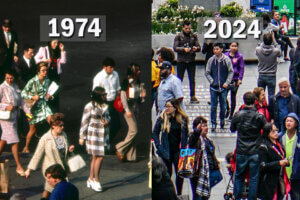West Long Branch, NJ – Despite some recent novel ideas from President Donald Trump, public opinion on illegal immigration and building a border wall have not budged in the latest national Monmouth University Poll. While most Americans think that illegal immigration is a problem, few say that illegal immigrants commit more crimes or take jobs away from Americans. A majority continue to oppose building a wall along the southern border. Among the new ideas Trump has floated, the public tends to favor detaining asylum-seekers in Mexico but are more divided on his proposal to release immigrants into “sanctuary cities.”
Seven-in-ten Americans see illegal immigration as either a very serious (46%) or somewhat serious (25%) problem. Another 16% say it is not too serious and 12% not at all serious. These results are in line with polls taken since late 2015. Republicans are the most likely partisan group to say this is a very serious problem (77%) – a feeling that is more widespread than four years ago (66%). Only 26% of Democrats feel that illegal immigration is a very serious problem, down slightly from 2015 (33%). Just over 4-in-10 independents feel the problem is very serious (43%), nearly identical to 2015 (42%).
A majority of the public (56%) continues to oppose building a wall along the U.S. border with Mexico, compared with 42% who support it. Opposition has ranged between 51% and 60% since Trump took office, while support for the wall has ranged between 35% and 44%. Early in the 2016 presidential cycle, when Trump made the wall a key campaign issue, public opinion was more in favor of building it at 48% support and 43% oppose. Most of the drop in support since the campaign has come from Democrats, going from 31% in 2015 to just 12% in the current poll. Over the same period, support has gone up slightly among Republicans (from 73% to 79%) and down slightly among independents (from 47% to 42%).
“Illegal immigration is clearly a problem, but the wall is not a solution. This has been the majority view since Trump took office,” said Patrick Murray, director of the independent Monmouth University Polling Institute.
The president has floated a number of ideas for dealing with immigrants who want political asylum. Just over half of Americans (51%) agree with the policy implemented earlier this year of keeping asylum-seekers in Mexico while their claims are being processed compared with 41% who say they should be allowed into the U.S. while they wait. A plurality of the public (46%) is inclined to believe that asylum-seekers are just trying to get around the normal process of applying for entry into the country compared with 37% who believe that these immigrants really are fleeing violence in their home countries. There are predictable partisan divisions in these findings. Republicans are more likely to feel asylum-seekers are skirting the normal entry process (71%) and that they should be made to wait in Mexico (83%). Democrats are more likely to feel that claims of fleeing violence are genuine (58%) and they should be granted entry to the U.S. while their applications are processed (62%). Independents are divided on both the authenticity of asylum-seekers’ claims (43% say it is a ruse to get around the process and 36% say it is for genuine reasons) and where to detain these immigrants while their applications are reviewed (47% in Mexico and 43% in U.S.).
A more recent proposal is to relocate detained immigrants who are ready for release only to places that have declared themselves as sanctuary cities. American opinion is divided, with 46% who support this idea and 43% who are opposed. A majority of Republicans (55%) and independents (52%) favor this idea while few Democrats (31%) agree. When informed that President Trump supports this idea, 71% say it does not change their mind, while 16% say it makes them less likely to support the idea and 10% say it makes them more likely to support it. In effect, this does not change overall opinion on the sanctuary cities relocation proposal.
“I think it is difficult for the public to fully process these novel approaches, some of which were floated in a tweet. If the president’s aim is to keep the immigration debate off balance, it may be mission accomplished,” said Murray.
One rationale for many of the proposals, including the border wall, is to prevent an influx of violent criminals. However, most Americans do not believe that illegal immigrants are more likely than other U.S. residents to commit violent crimes. Just 21% say they are more likely to commit crimes like rape or murder, while 50% say they are about as likely as other Americans to do this, and 24% say they are actually less likely to commit these types of crimes. These results are fairly consistent with prior polls since 2015.
In terms of economic impacts of illegal immigration, few people (24%) feel that illegal immigrants take away jobs from American citizens. Most (60%) say illegal immigrants fill jobs that Americans do not want. There are no significant differences in these results by income level. This opinion has not shifted significantly since 2015.
“When the public breaks down the impact of illegal immigration, few point to concerns that really hit close to home. But it’s an issue that draws on Americans’ emotions and Trump has been successful in keeping the narrative emotional,” said Murray.
The Monmouth University Poll was conducted by telephone from April 11 to 15, 2019 with 801 adults in the United States. The question results in this release have a margin of error of +/- 3.5 percentage points. The poll was conducted by the Monmouth University Polling Institute in West Long Branch, NJ.
QUESTIONS AND RESULTS
(* Some columns may not add to 100% due to rounding.)
[Q1-7 previously released.]
8. How serious a problem do you think the issue of illegal immigration is for the United States right now – very, somewhat, not too, or not at all serious?
| TREND: |
April 2019 |
Nov. 2018 |
Jan. 2018 |
Sept. 2017 |
Sept. 2015 |
| Very serious | 46% | 49% | 45% | 43% | 45% |
| Somewhat serious | 25% | 21% | 25% | 30% | 30% |
| Not too serious | 16% | 15% | 16% | 17% | 15% |
| Not at all serious | 12% | 13% | 13% | 10% | 9% |
| (VOL) Don’t know | 1% | 1% | 1% | 1% | 2% |
| (n) | (801) | (802) | (806) | (1,009) | (1,009) |
9. Do you favor or oppose building a wall along the U.S. border with Mexico?
| TREND: |
April 2019 |
March 2019 |
Jan. 2019 |
Jan. 2018 |
Sept. 2017 |
Sept. 2015 |
| Favor | 42% | 44% | 44% | 40% | 35% | 48% |
| Oppose | 56% | 51% | 52% | 57% | 60% | 43% |
| (VOL) Don’t know | 3% | 4% | 4% | 3% | 5% | 10% |
| (n) | (801) | (802) | (805) | (806) | (1,009) | (1,009) |
10. Do you think illegal immigrants coming to this country today take jobs away from American citizens, or do they mostly take jobs Americans don’t want?
| TREND: |
April 2019 |
Sept. 2017 |
Sept. 2015 |
| Take jobs away from American citizens | 24% | 23% | 26% |
| Take jobs Americans don’t want | 60% | 59% | 59% |
| (VOL) Both | 9% | 12% | 10% |
| (VOL) Don’t know | 7% | 5% | 6% |
| (n) | (801) | (1,009) | (1,009) |
11. Do you think illegal immigrants are more likely, less likely, or about as likely as other Americans to commit violent crimes like rape or murder?
| TREND: |
April 2019 |
Nov. 2018 |
Sept. 2015 |
| More likely | 21% | 21% | 17% |
| Less likely | 24% | 24% | 20% |
| About as likely | 50% | 51% | 59% |
| (VOL) Don’t know | 5% | 4% | 4% |
| (n) | (801) | (802) | (1,009) |
12. Should immigrants seeking political asylum at the border be allowed into the U.S. while they wait for their claims to be processed or should they be made to stay in Mexico?
|
April 2019 | |
| Allowed into the U.S. | 41% |
| Made to stay in Mexico | 51% |
| (VOL) Don’t know | 8% |
| (n) | (801) |
13. Do you think immigrants who come to the border seeking political asylum are really fleeing violence or are they just trying to get around the normal process of applying for entry to the country?
|
April 2019 | |
| Really fleeing violence | 37% |
| Trying to get around the normal process | 46% |
| (VOL) Don’t know | 17% |
| (n) | (801) |
[Note: Questions 13A and 13B were only asked 4/12-4/15; n=624, m.o.e. +/-3.9%]
13A. Some have proposed that immigrants who were originally detained at the border but are now ready for release should be relocated only to places that have declared themselves “sanctuary cities.” Do you support or oppose this idea?
|
April 2019 | |
| Support | 46% |
| Oppose | 43% |
| (VOL) Depends | 4% |
| (VOL) Don’t know | 7% |
| (n) | (624) |
13B. This idea has been proposed by President Trump. Does that make you more likely or less likely to support the idea, or doesn’t it change your opinion?
|
April 2019 | |
| More likely | 10% |
| Less likely | 16% |
| Doesn’t change opinion | 71% |
| (VOL) Don’t know | 3% |
| (n) | (624) |
[Q14-17 and 23-24 previously released.]
[Q18-22 and 25-31 held for future release.]
METHODOLOGY
The Monmouth University Poll was sponsored and conducted by the Monmouth University Polling Institute from April 11 to 15, 2019 with a national random sample of 801 adults age 18 and older, in English. This includes 320 contacted by a live interviewer on a landline telephone and 481 contacted by a live interviewer on a cell phone. Telephone numbers were selected through random digit dialing and landline respondents were selected with a modified Troldahl-Carter youngest adult household screen. Monmouth is responsible for all aspects of the survey design, data weighting and analysis. Final sample is weighted for region, age, education, gender and race based on US Census information. Data collection support provided by Braun Research (field) and Dynata (RDD sample). For results based on this sample, one can say with 95% confidence that the error attributable to sampling has a maximum margin of plus or minus 3.5 percentage points (unadjusted for sample design). Sampling error can be larger for sub-groups (see table below). In addition to sampling error, one should bear in mind that question wording and practical difficulties in conducting surveys can introduce error or bias into the findings of opinion polls.
| DEMOGRAPHICS (weighted) |
| Self-Reported |
| 25% Republican |
| 44% Independent |
| 31% Democrat |
| 48% Male |
| 52% Female |
| 30% 18-34 |
| 33% 35-54 |
| 37% 55+ |
| 64% White |
| 12% Black |
| 16% Hispanic |
| 8% Asian/Other |
| 69% No degree |
| 31% 4 year degree |
Click on pdf file link below for full methodology and crosstabs by key demographic groups.




